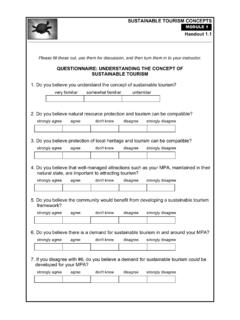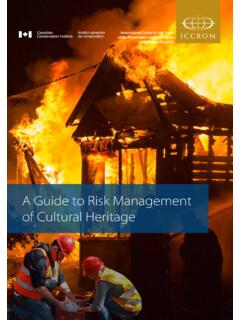Transcription of Inuit History and Heritage - Inuit Tapiriit Kanatami
1 Inuit History and Heritage Our 5000 Year Heritage .. 2 Unity of Culture and Language .. 3 The Origin of Our Culture .. 4 Our Earliest History .. 5 Our Ancestors .. 8 Europeans Discover Our Land and Culture .. 10 Meeting of Two Worlds .. 11 Inuit Today .. 14 The Inuit Regions .. 16 Inuvialuit region .. 16 Nunavut .. 16 Nunavik .. 17 Nunatsiavut .. 17 Inuit Tapiriit Kanatami Page 1 Our 5000 Year Heritage For 5,000 years, the people and culture known throughout the world as Inuit have occupied the vast territory stretching from the shores of the Chukchi Peninsula of Russia, east across Alaska and Canada, to the southeastern coast of Greenland.
2 It is here, based on our ability to utilize the physical environment and living resources of this geographic region known as the Arctic, where our culture developed and our History unfolded. Inuit are an original people of the land now known as Canada, and our History represents an important and fascinating story. It is not just a story about an early chapter of Canadian History . Indeed it is an epic tale in the History of human settlement and the endurance of culture. Each chapter of our story provides valuable lessons and insights about issues that matter to cultures everywhere. Our History is about people and their relationship to the environment and to each other; about dealing with change as well as the causes and consequences of change forced on us through colonialism; and about how we have reestablished control over our cultural, economic and political destiny through land claims and self government.
3 Above all, the story of Inuit is about how we as a culture are able to live in balance with the natural world. This is a story that we must begin to tell for ourselves. Unfortunately until now, most of the research on our culture and History has been done by individuals who come from outside our culture. Since the information that these individuals collected was seldom made available to us, the image held by much of the outside world about who we are is usually someone else's creation, not ours. It will take time to change this situation and we as Inuit are certainly prepared to work cooperatively with those who have devoted their professional lives to the study of our culture.
4 In the meantime we will reinterpret the information gathered by others to help us speak about ourselves. This website represents an important step in that direction as it carries our own story throughout the world. We will start by explaining that Inuit are not the only people living in the Arctic. We share the polar region with other indigenous cultures. As Canadian Inuit we have close ties with the Yupik and Inupiat of Alaska and Russia and with the Inuit of Greenland. We have more distant biological and linguistic links with the Aleut. There are other indigenous cultures occupying the circumpolar regions of Europe and Russia each having a distinct History and cultural tradition.
5 Recently, however, there has been a movement to unite indigenous peoples throughout the circumpolar world based on shared concerns especially about the Arctic environment and the benefits to be derived from economic cooperation and cultural exchange. Inuit Tapiriit Kanatami Page 2 Unity of Culture and Language As Inuit we divide ourselves into two closely related groups based on language, environmental factors and certain cultural features. The first is the Yupik who occupy coastal southwestern Alaska, Nunivak and St. Lawrence islands and a small sector of the southeastern Chukchi Peninsula. There are approximately 25,000 Yupik living in Alaska and 1,300 in Russia.
6 Although the Yupik language has the same origin as ours, it is not understood by Inuit . Besides language there are many other cultural features that distinguish Yupik from Inupiat and Inuit . The second group includes the Inupiat of north Alaska and eastern Russia, the Inuit of Canada, and the Inuit of Greenland. Of these 152,000 Inuit , 2,000 live in Russia, 50,000 in Alaska, 45,000 in Canada and 55,000 in Greenland. Although certain differences in culture and language should be expected over such a vast expanse of Arctic territory, one of the truly amazing aspects of our culture is the extent of similarity from one group to another as you travel from the eastern shore of Greenland west across what is now Canada and Alaska to the shores of Siberia.
7 In the 1920's, for example, Knud Rasmussen, an Inuk ethnographer from Greenland, traveled by dog team from Greenland, west across Canada to the north coast of Alaska. As he did so, he was able to collect a vast quantity of information that we as Inuit can now use to help us understand our History and our cultural traditions. During his epic trip, Knud Rasmussen was able to understand without great difficulty, all of the dialects he encountered along the way. In addition to language, Inuit from Siberia to Greenland share a similar cultural History at least up to the time of contact with the outside world; we share many of the same values, stories, traditions and technology; and of course, Inuit everywhere take pride in being able to make our life comfortable and sustainable in what is so often described by outsiders as a hostile, even unlivable environment.
8 Today some Inuit still travel by dog sledge while others prefer the snowmobile, all terrain vehicles, or powerful boats. But the places we go at different seasons of the year and the reason we go to these places have remained almost unchanged since the first groups of Inuit established a network of living sites and travel routes connecting them to their seasonal land and marine hunting areas. For the most part, different Inuit groups across the Arctic established their own patterns of living sites, travel routes and land use. These areas, however, overlapped so that a network of travel routes extended from the shores of Labrador to the shores of the Bering Sea.
9 Inuit Tapiriit Kanatami Page 3 The Origin of Our Culture Although there are still many important questions to be answered, the available evidence tells us that within the vast geographic regions of the Arctic, our distant and more recent ancestors carved out a homeland and established a way of life that has retained a cultural identity, social coherence, and territorial integrity throughout each and every stage of our History . We think that it is true to say that no other living culture has maintained such a continuous and consistent way of life for such a long period of time over such a large territory. When we speak about the origins and History of our culture, we do so from a perspective that is different from that often used by non- Inuit who have studied our past.
10 For example, in our culture we do not divide the past from the present so we do not like to use terms such as "prehistory." Our History is simply our History and we feel that the time has come for us as Inuit to take more control over determining what is important and how it should be interpreted. To be of value , our History must be used to instruct our young and to inform all of us about who we are as Inuit in today's world. We do not want our History to confine us to the past. Our past is preserved and explained through the telling of stories and the passing of information from one generation to the next through what is called the oral tradition.







